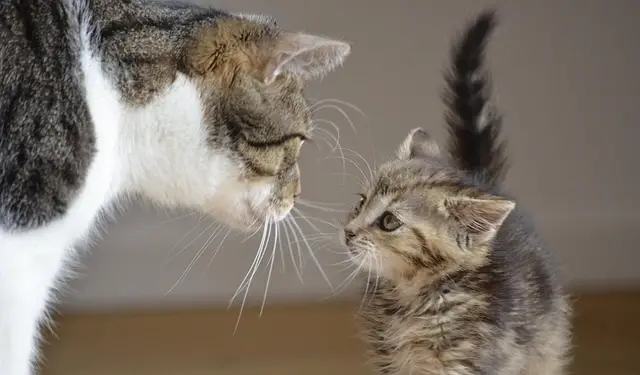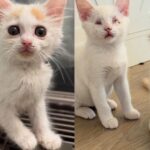Do you ever wonder why your cat acts the way it does? Why it pounces on anything that moves, or why it insists on scratching your furniture? Understanding your cat instincts can provide valuable insight into its behavior and help you better manage and care for your feline friend.
Just like their wild ancestors, domestic cats possess a range of innate instincts that drive their actions. By delving into these instincts, we can unlock the secrets behind their behaviors and learn how to meet their needs effectively.
General
In this article, we will explore the fascinating world of your cat instincts. From the hunting instinct that compels them to chase after prey-like toys, to the territorial instinct that drives them to mark their territory with scent, we will delve into what these behaviors mean and how you can manage them in a way that promotes a harmonious relationship between you and your furry companion.
So sit back, relax, and prepare to deepen your understanding of your cat’s natural instincts. Together, let’s uncover the mysteries behind those captivating behaviors and discover strategies for creating a happy and fulfilling life for both you and your beloved feline companion.
- General
- The Hunting Instinct
- The Territory Instinct
- The Social Instinct
- The Grooming Instinct
- The Scratching Instinct
- The Sleep Instinct
- The Play Instinct
- Frequently Asked Questions
- How can I help redirect my cat’s hunting instinct in a safe and appropriate way?
- What are some signs that my cat is marking its territory and how can I discourage this behavior?
- Are there any specific techniques to help socialize my cat and encourage positive interactions with other pets or humans?
- How often should I groom my cat and what are some tips for making this process more enjoyable for both of us?
- What are some effective ways to prevent my cat from scratching furniture and redirect this behavior to a scratching post?
- Conclusion
The Hunting Instinct
Imagine yourself watching your cat as it crouches low to the ground, its eyes focused intently on a small toy mouse, ready to pounce with lightning speed and precision. This is the hunting instinct in action. Cats are natural predators, and this behavior is deeply ingrained in their DNA.
While it may be entertaining to watch your feline friend engage in these hunting behaviors, it can also present challenges in a domestic setting. Fortunately, there are ways to manage hunting behavior and redirect those instincts towards more appropriate outlets. Providing interactive toys that simulate prey can help satisfy their need for hunting while protecting other household items from being targeted. Engaging your cat in play sessions also helps burn excess energy and keeps them mentally stimulated.
By understanding and accommodating their innate instincts, you can create a harmonious environment for both you and your furry companion.
Now let’s explore another important instinct: the territory instinct.
The Territory Instinct
Have you ever wondered why your furry friend is so protective of their territory?
Cats have a strong instinct to defend and mark their territory, and understanding this behavior can help you manage it effectively.
Signs of territorial aggression include aggressive behavior towards other cats or animals, urine marking, and excessive scratching or rubbing on furniture.
To manage your cat’s territorial behavior, provide them with plenty of vertical space like cat trees or shelves where they can perch and observe their surroundings.
Additionally, create designated areas for scratching and marking, such as scratching posts and litter boxes in different parts of the house.
Finally, consider using pheromone sprays or diffusers to help reduce stress and anxiety related to territorial issues.
By understanding and managing your cat’s territorial instincts, you can create a harmonious environment for both you and your furry friend.
Now let’s move on to the next section about ‘the social instinct’.
The Social Instinct
Get ready to explore the fascinating world of your furry friend’s social instinct and how it enriches their life and yours. Cats aren’t solitary creatures; they have a strong need for social interaction. Understanding cat behavior in social groups can help you create a harmonious environment for your pet.
Feline socialization techniques, such as gradual introductions, positive reinforcement, and providing vertical spaces, can help cats feel more comfortable in their social interactions.
Cats communicate through body language, vocalizations, and scent marking to establish boundaries and maintain social connections. They form complex hierarchies within their groups, which may include other cats or even humans. It’s important to respect their need for space while also providing opportunities for play and companionship.
As we delve deeper into understanding your cat’s instincts, let’s now transition to the next section about ‘the grooming instinct’ and how it contributes to their overall well-being.
The Grooming Instinct
Regular grooming is essential for the health and well-being of your cat. It not only helps to keep their coat clean and free from mats, but it also allows you to check for any skin issues or parasites. When grooming your cat, use gentle techniques such as brushing, combing, and bathing to ensure a positive experience. If you notice that your cat is excessively grooming themselves, it may be a sign of stress or an underlying medical condition. In such cases, it’s important to consult with a veterinarian for further guidance.
Importance of regular grooming
Maintaining a consistent grooming routine is crucial for keeping your cat healthy and happy. As the saying goes, “A clean cat is a contented cat.” Regular grooming tips include brushing your cat’s fur to remove loose hair and prevent matting. This not only keeps their coat looking sleek and beautiful, but also helps to reduce hairballs.
Additionally, regular grooming allows you to check for any skin issues or abnormalities that may require veterinary attention. Grooming also provides an opportunity for bonding with your feline friend and can help them feel relaxed and loved. By incorporating grooming into your cat’s routine, you are not only promoting their physical well-being, but also strengthening your relationship with them.
Transitioning into techniques for grooming your cat, it’s important to approach this task with patience and care.
Techniques for grooming your cat
One way to make grooming your cat a pleasant experience is by using gentle and soothing strokes while brushing their fur. This technique not only helps to remove any tangles or mats, but it also provides a calming effect for your feline friend.
When grooming your cat, it’s important to approach them with patience and confidence. Start by using short strokes in the direction of their fur growth, gradually increasing the length and pressure as they become more comfortable. Remember to pay attention to sensitive areas such as the belly and tail, using extra care when brushing these areas.
Additionally, incorporating positive reinforcement such as treats or praise can help create a positive association with grooming sessions. By following these techniques for cat grooming, you can ensure that both you and your cat have a pleasant experience.
Moving on to addressing excessive grooming behavior…
Addressing excessive grooming behavior
To tackle excessive grooming behavior, it’s crucial to first identify any underlying causes that may be contributing to the issue.
Cats may excessively groom themselves as a response to stress or anxiety. By managing excessive grooming behavior, you can help your cat feel more comfortable and reduce the risk of skin irritation or hair loss.
One way to address this behavior is by recognizing signs of stress in cats, such as increased vocalization, hiding, or changes in appetite. Providing a calm and enriched environment with plenty of opportunities for play and mental stimulation can help alleviate stress levels.
Additionally, using interactive toys or puzzles can redirect your cat’s focus away from grooming. Understanding your cat’s instincts and addressing their needs will create a harmonious environment for both you and your feline friend.
Now let’s delve into the fascinating world of the scratching instinct.
The Scratching Instinct
Understanding your cat’s scratching instinct is crucial for providing them with appropriate outlets for this natural behavior. Scratching serves multiple purposes for cats, including stretching their muscles, sharpening their claws, and marking their territory. To prevent furniture damage caused by scratching, it’s important to redirect your cat’s scratching behavior to more suitable surfaces.
Here are four strategies you can use:
- Provide a variety of scratching posts and boards throughout your home.nn2. Use positive reinforcement techniques to encourage your cat to use the designated scratching areas.nn3. Trim your cat’s nails regularly to reduce the potential damage caused by scratching.nn4. Consider using deterrents such as double-sided tape or aluminum foil on furniture edges to discourage unwanted scratching.
By understanding and addressing your cat’s scratching instinct, you can maintain a harmonious living space while ensuring your feline friend has an appropriate outlet for this natural behavior.
Transitioning into the topic of the sleep instinct, it’s equally important to provide cats with comfortable sleeping areas in order to support their overall well-being.
The Sleep Instinct
Understanding your cat’s sleep patterns is essential for providing them with a comfortable and restful environment. Creating a cozy sleeping space, such as a soft bed or blanket, can help promote relaxation and good quality sleep.
Additionally, establishing a routine for rest and relaxation can help regulate your cat’s sleep-wake cycle and ensure they get the rest they need to stay happy and healthy.
Understanding the sleep patterns of cats
Imagine waking up in the middle of the night to find your feline friend curled up next to you, peacefully snoozing away. Understanding the sleep patterns of cats can help us provide them with a comfortable environment for their much-needed rest.
Cats have unique sleep cycles that consist of both light and deep sleep stages. They often spend around 15 hours a day napping, but these periods are not continuous. Instead, cats alternate between short periods of light sleep and longer stretches of deep slumber. This pattern allows them to quickly awaken if necessary while still getting enough rest.
To create a comfortable sleeping environment for your cat, it is important to consider factors such as providing cozy bedding, reducing noise and disturbances, and ensuring a safe space where they can relax undisturbed.
[Transition: Now let’s explore some tips on creating a comfortable sleeping environment for your feline friend.]
Creating a comfortable sleeping environment
To ensure your feline friend has a purr-fectly cozy sleep, create an environment that’s as comforting as a warm embrace, allowing them to drift into dreamland with ease.
Cats are creatures of comfort and providing them with a cozy sleeping space is essential for promoting healthy sleep habits. Start by offering soft bedding such as blankets or cat beds that make them feel secure.
Position their sleeping area away from noise and distractions, ensuring peace and quiet during their restful moments. Additionally, consider the temperature in the room, making sure it’s neither too hot nor too cold for their sensitive senses.
By creating a comfortable sleeping environment, you’ll be setting the stage for your cat’s well-deserved relaxation time.
Transitioning into the subsequent section about establishing a routine for rest and relaxation, it’s important to note that cats thrive on predictability in their daily lives.
Establishing a routine for rest and relaxation
Creating a consistent routine for rest and relaxation is key to ensuring that your feline friend gets the quality sleep they need. Cats are creatures of habit, and by establishing a bedtime routine, you can help signal to your cat that it’s time to wind down and prepare for sleep.
Start by creating a cozy nap spot for your cat, such as a soft bed or blanket in a quiet corner of your home. Make sure this spot is away from any distractions or noise that could disrupt their sleep.
Additionally, try to stick to a regular schedule for feeding and playtime so that your cat’s body can adjust and anticipate when it’s time to rest.
By providing structure and consistency, you’ll be able to create an environment where your cat feels safe and secure enough to relax deeply. This will also help transition into the subsequent section about ‘the play instinct’, as maintaining a balance between rest and play is crucial for their overall well-being.
The Play Instinct

Playing is an essential aspect of a cat’s life, as it helps them to exercise, relieve stress, and fulfill their natural hunting instincts. When choosing toys for interactive play, opt for ones that simulate prey-like movements and textures to engage your cat’s interest. Engaging in playtime with your cat not only strengthens the bond between you both but also provides mental stimulation and promotes a healthy lifestyle for your feline friend.
Importance of play for cats
Are you aware of how crucial playtime is for your feline friend? It taps into their natural instincts and keeps them happy and healthy. Providing mental stimulation is just as important as physical exercise for cats. Incorporating play into their daily routine not only helps prevent boredom but also provides an outlet for their predatory instincts.
Interactive play can satisfy their need to chase, pounce, and stalk, which promotes a healthier lifestyle. Engaging in regular play sessions with your cat also strengthens the bond between you and provides an opportunity for socialization.
It’s essential to choose the right toys that encourage interactive play, such as wand toys or treat-dispensing puzzles. These toys keep your cat mentally stimulated while keeping them physically active. By incorporating interactive play into your cat’s routine, you are ensuring they have a fulfilled life filled with fun and enrichment before moving on to choosing the right toys for interactive play.
Choosing the right toys for interactive play
Selecting the appropriate toys for interactive play can be an exciting task as you envision your cat leaping and pouncing with delight. When choosing interactive toys, it’s important to consider your cat’s interests and instincts.
Opt for toys that mimic natural prey, such as feather wands or toy mice, to engage their hunting instincts. Interactive puzzle toys can provide mental stimulation while satisfying their innate curiosity.
Not only does interactive play keep your cat physically active, but it also provides mental enrichment and helps prevent boredom-related behaviors like excessive scratching or aggression. Engaging in regular interactive play sessions with your cat strengthens the bond between you two and fulfills their need for social interaction.
Transitioning into the next section, remember that understanding how to engage in playtime with your feline friend is crucial for a fulfilling relationship.
Engaging in playtime with your cat
When it comes to enjoying playtime with your feline companion, it’s all about finding the right toys and activities that bring out their inner adventurer. Engaging in playtime not only strengthens the bond between you and your cat but also provides them with much-needed mental and physical stimulation.
To encourage exercise and prevent boredom, consider incorporating the following activities into your playtime routine:
- Interactive puzzle toys: These toys stimulate your cat’s natural hunting instincts while providing mental enrichment. Fill them with treats or kibble to keep your cat engaged.
- Feather wands: Mimicking bird-like movements, feather wands are excellent for engaging your cat in active play. Wiggle the wand around to simulate prey and watch as your cat pounces and chases after it.
- Laser pointers: The elusive red dot is a great way to get your cat moving. However, always end the game with a tangible toy or treat to prevent frustration.
By incorporating these activities into playtime, you can help ensure that your furry friend stays active, happy, and mentally stimulated.
Frequently Asked Questions
How can I help redirect my cat’s hunting instinct in a safe and appropriate way?
To redirect your cat’s hunting instinct in a safe and appropriate way, engage them in interactive play with toys that mimic prey. This helps satisfy their natural instincts while reducing territorial marking behaviors.
What are some signs that my cat is marking its territory and how can I discourage this behavior?
To discourage marking behavior and manage territorial instincts in your cat, watch for signs like urine spraying or scratching furniture. Provide plenty of vertical space, use deterrents like pheromone sprays, and clean marked areas thoroughly to reduce the scent.
Are there any specific techniques to help socialize my cat and encourage positive interactions with other pets or humans?
To socialize your cat and encourage positive interactions with other pets and humans, use techniques like gradual introductions, positive reinforcement, and play therapy. The benefits include reducing aggression, anxiety, and stress levels.
How often should I groom my cat and what are some tips for making this process more enjoyable for both of us?
To reduce shedding, groom your cat regularly. Start by introducing grooming slowly to a fearful cat, using positive reinforcement and treats. Gradually increase the duration of grooming sessions while ensuring a calm and comfortable environment.
What are some effective ways to prevent my cat from scratching furniture and redirect this behavior to a scratching post?
To prevent your cat from scratching furniture, try positive reinforcement techniques like rewarding them with treats or praise when they use a scratching post. You can also use deterrents like double-sided tape or aluminum foil on furniture legs, and provide protective coverings for vulnerable areas.
Conclusion
In conclusion, understanding your cat instincts is crucial for managing their behavior effectively. By recognizing and respecting their hunting instinct, you can provide appropriate outlets for them to engage in natural behaviors.
Similarly, acknowledging territorial and social instincts will help create a safe and comfortable environment for your feline friend. Grooming, scratching, sleeping, and playing are all essential aspects of your cat’s nature that should be encouraged and facilitated.
Remember, by embracing these instincts symbolically, you can foster a deeper connection with your beloved pet based on mutual understanding and respect.
Read more:






























